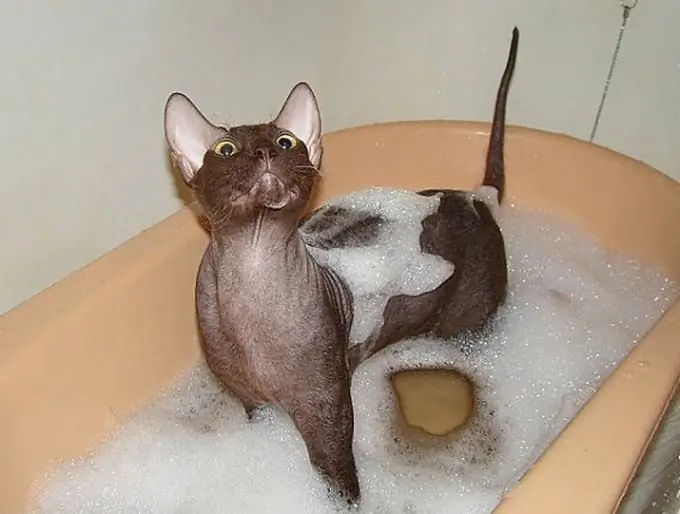- Author Delia Mathews [email protected].
- Public 2023-12-16 00:05.
- Last modified 2025-01-22 15:45.
Cats should not be bathed often - they are able to clean their fur with their tongue on their own. But sometimes bathing is still necessary, and it is very important to wash the animal correctly so as not to frighten, and the result was good.

Cat's hair is coated with grease - produced by the subcutaneous sebaceous glands. When bathing, the shampoo temporarily deprives the wool of such protection.
It is necessary to bathe the cat if parasites are found in the fur, or it is too dirty, and sometimes for preventive purposes - for example, if the animal has been in contact with others and there is a danger of catching fleas.
Long-haired and long-haired cats are more likely to need washing. It is more difficult for them to lick themselves, and if the animal is supposed to be sent to an exhibition, it must be washed in order to create a beautiful appearance. Short-haired cats do not need it so often, and the owners of sphinxes in this regard can only be envied.
It is impossible to wash cats with soap intended for humans because of the difference in the acid-base balance of the skin. Special shampoos for cat hair are available in liquid form, in a dry powdery state, in the form of a spray. Liquid products are best for washing, but don't use them often - they can disrupt the sebaceous glands.
Dry shampoos can be a real salvation if the animal is afraid of water. With them, the process is no more difficult than combing. The powder is applied to the wool, kept for as long as indicated in the instructions, then brushed off with a comb. When using sprays, you need to be more careful - the cat may be frightened by the sound of the spray can.
Washing with liquid shampoo is much more problematic, but sometimes you just can't do without it. Before starting the procedure, the cat must be calmed, held, stroked and talked to her. Some cats are not as intimidated by getting wet as the noise of the water pouring from the faucet.
The water should be poured into the bathtub, not into the basin, because the animal may begin to try to get out of the water. At the same time, cats grab the edges of the pelvis with their paws and can overturn it. The water level should be high enough to reach the cat's belly, and the temperature can be checked by lowering your own elbow there.
Place the cat in the bathtub and wet the hair with the water you have collected, but do not let it get into the ears. It is advisable to carry out the procedure with an assistant. You do not need to apply a lot of shampoo - such products foam a lot. Wash the animal's fur with massaging movements, gently roll it out of the pelvis or hose with a low pressure of water.
Remove the washed cat from the bath and wrap it in a towel, blot well. Several towels are required for long-haired individuals. If your cat is not afraid of a hair dryer, you can use it to dry the coat.






